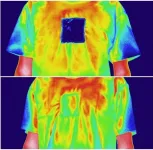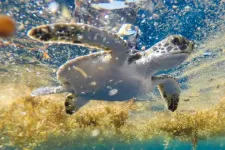(Press-News.org) Reflexes protect our bodies - for example when we pull our hand back from a hot stove. These protective mechanisms could also be useful for robots. In this interview, Prof. Sami Haddadin and Johannes Kühn of the Munich School of Robotics and Machine Intelligence (MSRM) of the Technical University of Munich (TUM) explain why giving test subjects a "slap on the hand" could lay the foundations for the robots of the future.
In your paper, published in Scientific Reports, you describe an experimental setup where people were actually slapped on the hand - to study their reflexes....
Kühn: Yes, you can put it that way. For our study, in cooperation with Imperial College London, the test subjects needed their reflexes to protect them against two different pain sources: first, a slap on the hand. And, while pulling their hand and arm out of harm's way, they also had to avoid an elbow obstacle. We studied the hand retraction and discovered that it is a highly coordinated motion.
We also observed that the pain anticipated by a person shapes the reflex: If I know that the object behind me will cause similar pain to the slap on my fingers, I will withdraw my hand differently than when I know that the object will cause no pain.
How can such a seemingly simple experiment contribute to the development of intelligent high-tech machines like robots?
Haddadin: Humans have fascinating abilities. One could speak of a built-in intelligence in the human body that is indispensable for survival. The protective reflex is a central part of this. Imagine the classical "hand on the hot stove" situation. Without thinking, we pull back our hand as soon as the skin senses heat. So far, robots do not have reflexes of this kind. Their reactions to impending collisions tend to be rather mindless: They just stop and don't move until a person takes action.
In some situations this might make sense. But if a robot simply stopped moving when touching a hot stove, this would obviously have fatal consequences. At the MSRM we are therefore interested in developing autonomous and intelligent reflex mechanisms as part of a central nervous system for robots, so to speak. Humans are serving as our role models. How do their reflexes work and what can we learn from them for the development of intelligent robots?
What conclusions can you draw from your experiment for the development of robots?
Kühn: We gained an insight into how the reflex motion works in detail: The way humans coordinate the reflex can be seen as throwing the shoulder forward, in a sense, in order to accelerate the withdrawal of the hand. This principle could be applied in the development of reflex motions in humanoid robots, with a signal sent to one part of a robot in order to influence the motion of another one.
This knowledge will also be helpful in the design of robot-enabled prosthetics that are expected to perform in "human-like" ways.
You mentioned that "anticipated pain" played a role in your experiment. Should robots be able to anticipate pain, too?
Kühn: That would be a big advantage. It could help to classify potential collisions based on danger levels - and to plan evasive actions if appropriate. This would not only ensure the safety of the robot.
If the robot were capable of anticipating human pain, it could intervene in a dangerous situation to save a person from experiencing this pain.
Would robots then need to learn how to feel pain in the same way as humans?
Haddadin: No. Our pain perception is highly complex and linked to emotions. So we can't compare this to a human's "pain sensation". Robots are tools and not living creatures. Artificial pain is nothing more than a technical signal based on data from various sensors. At the MSRM we have already developed an initial reflex mechanism for robots based on "artificial pain". When touching hot or sharp objects, our robot withdrew its arm in a reflexive movement.
What are your next steps on the way to a robot with a fully developed protective reflex?
Haddadin: The big challenge in our research field between humans and machines is that we still have only a rudimentary understanding of our role model: the human reflex system, working with the sensorimotoric learning mechanisms of a complex, neuromechanical motion apparatus. And that is where the exciting scientific challenge lies: with all of the unknowns, to continually improve the human-inspired abilities of our intelligent machines, while using what we learn to arrive at a better understanding of how humans function. Basically, we can say that this has continued since the days of Leonardo Da Vinci and will carry on for many years to come.
INFORMATION:
Clothing, from tank tops to parkas, helps people adapt to temperatures outdoors. But you can only put on or take off so much of it, and fluctuations in weather can render what you are wearing entirely inadequate. In a new study in ACS' Nano Letters, researchers describe a high-tech alternative: a reversible textile they designed to trap warmth in the cold and reflect it during hot weather, all while generating small amounts of electricity.
Previous attempts to develop such sophisticated textiles for outdoor use have generally focused on either capturing thermal radiation or dispersing it. To integrate the two, Qiang Li, Min Qiu and colleagues made a ...
More research is urgently needed into the impact that attending suicide events is having on paramedics and other first responders, a researcher at the University of Otago, New Zealand, says.
PhD student Renan Lyra, a psychologist by training, says a significant proportion of police officers, firefighters and paramedics will attend at least one suicide event in their careers, but there has been little research into the impact this has on their personal and professional lives and on their own suicide risk.
Mr Lyra has reviewed 25 research papers on the impact attending a suicide event has on those ...
A curiously yellow star has caused astrophysicists to reevaluate what's possible within our universe.
Led by Northwestern University, the international team used NASA's Hubble Space Telescope to examine the massive star two-and-a-half years before it exploded into a supernova. At the end of their lives, cool, yellow stars are typically shrouded in hydrogen, which conceals the star's hot, blue interior. But this yellow star, located 35 million lightyears from Earth in the Virgo galaxy cluster, was mysteriously lacking this crucial hydrogen layer at the time of its explosion.
"We haven't seen this scenario before," said Northwestern's ...
CATONSVILLE, MD, May 4, 2021 - Paid video streaming services on your television, smart phone or other devices are increasingly replacing traditional video entertainment platforms of cable, satellite and broadcast TV. The growth of these services, known in the industry as over-the-top (OTT) media services, may be accompanied by a rise in pirated content, particularly where access to those services may be restricted, a group of researchers has found.
The researchers studied the effects of the Netflix - one of the leading global companies in paid video streaming - and its growth in 40 Asian countries. They also studied one country where access to Netflix was restricted, which is where ...
Carnegie Mellon University's He Lab is focusing on noninvasive neuroengineering solutions that not only provide diagnostic techniques, but also innovative treatment options. Their latest research has demonstrated that noninvasive neuromodulation via low-intensity ultrasound can have cell-type selectivity in manipulating neurons.
Parkinson's Disease, epilepsy and insomnia are just a few of the neurological disorders that use neuromodulation treatment techniques today. Neuromodulation delivers controlled physical energy to the nervous system to treat and improve patients' quality of life. Current neuromodulation approaches, while effective, bring both drawbacks and limitations.
"Deep ...
When light hits certain molecules, it dislodges electrons that then move from one location to another, creating areas of positive and negative charge. This "charge transfer" is highly important in many areas of chemistry, in biological processes like photosynthesis and in technologies like semiconductor devices and solar cells.
Even though theories have been developed to explain and predict how charge transfer works, they have been validated only indirectly because of the difficulty of observing how a molecule's structure responds to charge movements with the ...
Researchers from the UCLA School of Dentistry have discovered a key molecule that allows cancer stem cells to bypass the body's natural immune defenses, spurring the growth and spread of head and neck squamous cell cancers. Their study, conducted in mice, also demonstrates that inhibiting this molecule derails cancer progression and helps eliminate these stem cells.
Published in the journal Cell Stem Cell, the findings could help pave the way for more effective targeted treatments for this highly invasive type of cancer, which is characterized by frequent resistance to therapies, rapid metastasis and a ...
A hot topic symposia session during thePediatric Academic Societies (PAS) 2021 Virtual Meeting will provide a forum for policy and physician experts to predict major child health legislative and policy changes which will occur over the next four years.
The outcome of the presidential election has significant impact on the child health policy agenda. The goal of the session is to prepare academic pediatricians so they can be ideally positioned to promote or impede specific policies which are not evidenced-based to improve child health.
"The subject matter ...
The emergence and spread of new forms of resistance remains a concern that urgently demand new antibiotics. Transcription is a vital process in bacterial cell, where genetic information in DNA is transcribed to RNA for the translation of proteins that perform cellular function. Hence, transcription serves as a promising target to develop new antibiotics because inhibition the transcription process should effectively kill the bacteria. Bacterial RNA Polymerase, the core enzyme for transcription, must load the DNA and separate the double-stranded DNA to single stranded DNA to read the genetic information to initiate transcription. This process is also called DNA melting and is facilitated ...
ORLANDO, May 5, 2021 - New research indicates that the legendary Sargasso Sea, which includes part of the Bermuda Triangle and has long featured in fiction as a place where ships go derelict, may actually be an important nursery habitat for young sea turtles.
In a study led by a University of Central Florida researcher and published today in the journal Proceedings of the Royal Society B, researchers presented evidence of baby green sea turtles arriving at the Sargasso Sea after entering the ocean off the east coast of Florida.
The study was the first time that green sea turtles have been tracked during their early "lost years," which is defined ...







